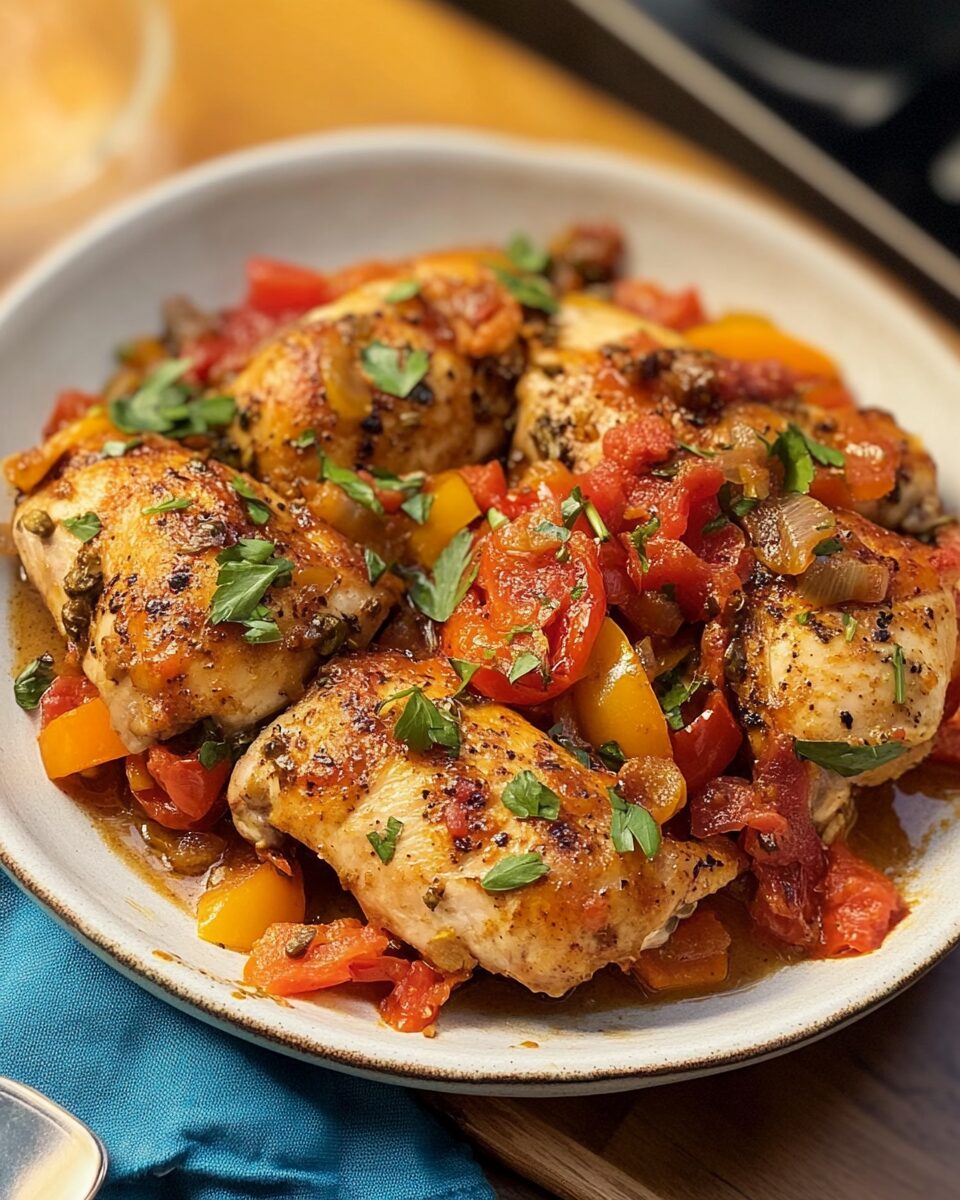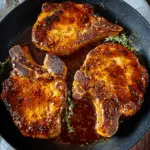Roman Chicken is a dish steeped in tradition and comfort. Juicy chicken pieces are simmered gently with colorful bell peppers, salty prosciutto, and a bright, herb-laced tomato sauce. The capers bring a subtle briny finish, perfectly balancing the sweet tomatoes and rich chicken.
Whether served with rustic bread, creamy polenta, or al dente pasta, this dish is the epitome of Italian home cooking. The aroma alone—thanks to fresh thyme, oregano, and garlic—will transport you to a sun-drenched kitchen in the hills of Rome. Perfect for family dinners, yet elegant enough for guests, Roman Chicken is a timeless classic you’ll return to again and again.
Full recipe:
-
1 tablespoon fresh thyme leaves
-
1 teaspoon fresh oregano leaves
-
1/2 cup chicken broth
-
2 tablespoons capers, rinsed
-
1/4 cup chopped fresh Italian parsley
Directions:
-
Season the chicken pieces with salt and pepper.
-
In a large heavy skillet, heat the olive oil over medium heat.
-
Brown the chicken pieces until golden, about 5 minutes per side. Remove from pan and set aside.
-
In the same pan, add the bell peppers and prosciutto. Sauté for about 5 minutes until the peppers are soft.
-
Add garlic and cook for 1 minute.
-
Add the tomatoes with their juice, wine, and herbs. Stir to combine.
-
Return the chicken to the pan and pour in the broth. Bring to a boil.
-
Reduce heat, cover, and simmer for 20–30 minutes until the chicken is cooked through.
-
Stir in capers and parsley before serving.
Prep Time: 15 minutes | Cooking Time: 40 minutes | Total Time: 55 minutes
Kcal: 345 kcal | Servings: 6 servings
The History Behind Roman-Style Chicken
The origins of Roman Chicken can be traced back to traditional Roman countryside cooking, where meals were often prepared with whatever fresh ingredients were available. The dish is believed to have evolved in rural kitchens, where frugality and flavor had to coexist. Using whole cuts of chicken allowed for economical meal planning, while the addition of local ingredients like bell peppers and herbs from home gardens brought freshness and vibrance.
As Italian cuisine spread globally and chefs began to experiment with homey classics, dishes like Roman Chicken gained new popularity. Today, it is a staple in many Italian-American households and is celebrated for its heartiness, nutritional value, and comforting character.
Why Roman Chicken is a Standout Dish
One of the most remarkable things about Roman Chicken is how effortlessly it bridges rustic tradition and gourmet flair. Unlike heavier chicken dishes that rely on cream or cheese, Roman Chicken gets its richness from carefully browned meat, olive oil, and a balance of sweet bell peppers with a savory tomato-wine sauce. The result is a dish that feels indulgent without being overly rich.
Its standout feature is the layering of flavor: searing the chicken adds caramelized depth, sautéed peppers offer both color and sweetness, prosciutto introduces an umami-laden bite, and the capers lend a pop of briny brightness that lifts the entire dish. Every component plays a role, and the cooking technique allows each ingredient to shine.
Nutritional Benefits and Health Aspects
Roman Chicken is not only delicious but also relatively healthy when compared to other comfort dishes. Bone-in chicken pieces offer lean protein and flavor, especially when the skin is removed or minimized. Bell peppers are rich in vitamin C and antioxidants, while herbs like thyme and oregano provide anti-inflammatory properties and essential oils that aid digestion.
The dish uses a tomato base, which is low in calories and packed with lycopene, a powerful antioxidant. The inclusion of olive oil—an essential fat in the Mediterranean diet—adds heart-healthy monounsaturated fats. Additionally, the capers provide a burst of flavor without the need for excess salt, keeping sodium levels in check while boosting taste.
Best Ways to Serve Roman Chicken
Roman Chicken is highly versatile and pairs beautifully with a variety of sides. In Italy, it’s commonly served with crusty rustic bread, ideal for soaking up the savory tomato broth. It also goes wonderfully with creamy polenta or a bowl of al dente pasta, such as tagliatelle or penne, for a more filling meal.
For a lighter option, Roman Chicken can be served atop a bed of sautéed greens or steamed vegetables. Roasted potatoes, risotto, or even farro salad are excellent pairings that round out the meal while maintaining a cohesive flavor profile.
It’s also a great candidate for make-ahead meals, as the flavor deepens when the dish is reheated. The leftovers are just as delightful the next day, making it a practical option for meal planning or busy weeknight dinners.
Wine Pairing Recommendations
Given the savory and slightly tangy profile of Roman Chicken, an ideal wine pairing would be a light to medium-bodied white wine with good acidity. A classic Italian white like Frascati or Vermentino offers the citrusy brightness needed to cut through the richness of the chicken and the prosciutto.
Alternatively, a Pinot Grigio or Sauvignon Blanc would also pair well, as these wines echo the herbaceous notes found in the dish. If you prefer red, opt for a light red wine such as Chianti or Barbera. These offer fruit-forward profiles without overpowering the subtleties of the sauce.
Cooking Tips for Maximum Flavor
To make the most flavorful Roman Chicken, focus on browning the chicken properly. Don’t rush this step—allow the chicken pieces to develop a golden crust before removing them from the pan. This searing creates the foundation of flavor that infuses the rest of the sauce.
Another tip is to deglaze the pan thoroughly with the white wine after sautéing the vegetables. This lifts all the caramelized bits (fond) from the bottom of the pan and reincorporates them into the sauce. Use fresh herbs wherever possible; their oils are more potent and will infuse the dish with a cleaner, brighter aroma.
When simmering, keep the heat low and steady. Slow cooking allows the flavors to meld together harmoniously and ensures that the chicken stays tender and juicy. Just before serving, add the capers and fresh parsley—this preserves their sharp, fresh character and contrasts the warm, rich sauce.
Cultural Significance of Roman Chicken
Italian cuisine is deeply rooted in regional pride, and dishes like Roman Chicken are a testament to the identity of a specific place—in this case, Rome and its surrounding countryside. Roman Chicken carries with it the soul of cucina povera, or “poor cooking,” which celebrates minimalism and resourcefulness.
In Roman households, this dish is often reserved for Sunday meals or festive family gatherings. It’s hearty, communal, and designed to be shared. Making Roman Chicken is about more than just feeding the body; it’s about tradition, connection, and honoring generations of cooks who used humble ingredients to craft something exceptional.
Modern Adaptations and Variations
While the traditional recipe is a gem in itself, Roman Chicken lends well to creative adaptations. For instance, some modern cooks might add mushrooms for an earthy dimension or substitute pancetta for prosciutto to change the texture and flavor slightly. Others might add a dash of crushed red pepper for a bit of heat.
For those following a gluten-free or dairy-free lifestyle, this dish is naturally compliant. It’s also easy to adapt for Whole30 or Paleo diets by adjusting the wine and checking the labels on any processed ingredients.
You can even transform leftovers into a shredded chicken pasta, sandwich filling, or a base for baked casseroles. The possibilities are wide, making Roman Chicken not just a recipe but a launching pad for culinary creativity.
Conclusion
Roman Chicken is more than just another chicken dish—it’s a culinary experience rooted in Italian tradition, celebrated for its simplicity, complexity, and versatility. With minimal ingredients and a one-pan approach, it delivers layers of flavor that feel both comforting and elegant.
Perfect for weeknight dinners, special occasions, or as part of a Sunday family meal, Roman Chicken proves that classic recipes never go out of style. Whether you’re new to Italian cooking or a seasoned enthusiast, this dish offers a rewarding and deeply satisfying addition to your repertoire.
Bring a bit of Rome to your table and savor every bite of this timeless favorite.






